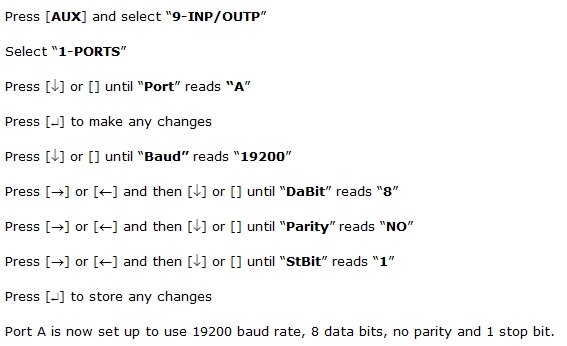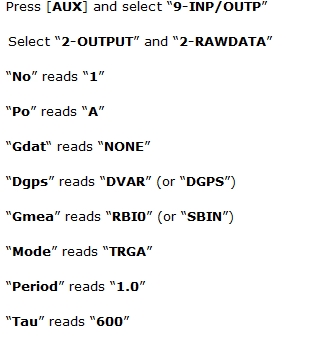Sercel NR203 (Active Correction) - 13
Description
Driver for interrogation of Sercel NR203.
Driver to be used to obtain raw GPS pseudo-ranges and various GPS broadcast data (as well as differential corrections) from a Sercel NR203 series GPS receiver.
Driver Information
Driver | Sercel NR203 | Interface Type | Serial | Driver Class Type | Interrogated |
|---|---|---|---|---|---|
No | Input / Output | Input (two-way) | Executable | DrvNR203.exe | |
Related Systems |
| ||||
Related Pages | |||||
System Configuration
To configure Sercel NR203 receivers, use the AUX and DIF menus on the receiver.
It is important to know that Qinsy should be connected to Port A, which is an RS-232 serial port.
The other ports are not capable of outputting raw data or are not RS-232 ports.
Configuring Port A:
 |
Checking Selected Messages and Activated Output:
Qinsy uses the Sercel command RAWDAT to modify the output when the driver is started or reset.
After the NR203 driver has been started or used by Qinsy, the result of RAWDAT can be checked:
 |
Port A is now set up to output compacted ephemerides (on trigger request), differential corrections and binary smoothed pseudo ranges the GPS event after a trigger pulse on pin 1 of port A.
Interfacing Notes
It is important that the wiring is bi-directional and that pin 1 of port A is connected to receive a DTR signal from the COM port. Every time Qinsy needs pseudo-ranges, differential corrections or ephemerides (e.g. at initialisation), it will ask the receiver for it. This also applies to the case where only corrections are read.
The wiring of port A of a Sercel NR203 receiver to a 9-pin or 25-pin COM port (e.g. Digi 8e) is as follows:
DB-9 | Port A | DB-9 | COM | DB-25 | COM | ||
|---|---|---|---|---|---|---|---|
Pin 1 | TRG | ------- | Pin 4 | DTR | Pin 20 | DTR | |
Pin 2 | TXD | ------- | Pin 2 | RXD | Pin 3 | RXD | |
Pin 3 | RXD | ------- | Pin 3 | TXD | Pin 2 | TXD | |
Pin 5 | SG | ------- | Pin 5 | SG | Pin 7 | SG |
Note. It is important that the wiring is bi-directional, even in the situation that only corrections are to be read. Data output (raw pseudo-ranges and differential corrections) is triggered by a signal on pin 1 of port A.
CONNECTING THE SERCEL NR 203 USING PORT I OR J
If RS232C Port A is used for raw data, then RS422 Port I or J can be used to output other data, for example the position computed by the Sercel NR203 contained in a NMEA $GPGGA string. The (one-directional) wiring for an ASCII string between the 9-pin RS422 port I (or J) and a serial COM port must be as follows.
DB-9 | Port I | DB-9 | COM | DB-25 | COM | ||
|---|---|---|---|---|---|---|---|
Pin 1 | SG | Pin 2 | RXD | Pin 3 | RXD | ||
Pin 8 | TXD+ | Pin 5 | SG | Pin 7 | SG | ||
Pin 9 | TXD- |
Database Setup
If the differential corrections from the Sercel NR203 are also to be used, select the item "Auxiliary systems" and add a new "Differential corrections system" to the Qinsy Database.
Select the "Sercel NR203 (Passive Corrections)" driver and use the same interface parameters as with the satellite navigation system driver.
Use the station ID's (including any leading zero's) as slot numbers for the stations. Refer to the NR203 manual for how to obtain these ID's.
